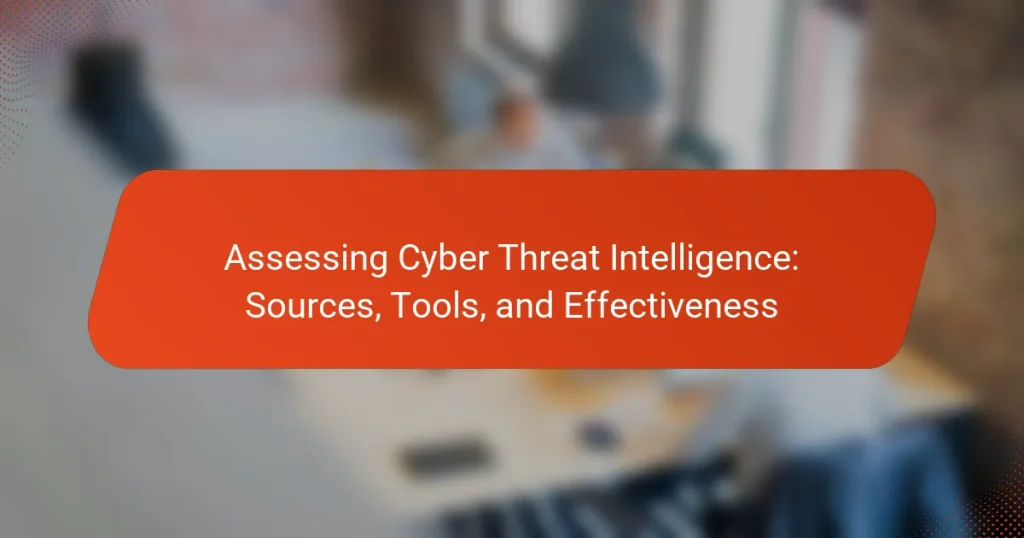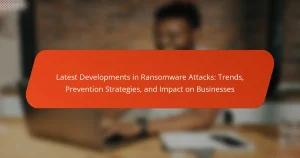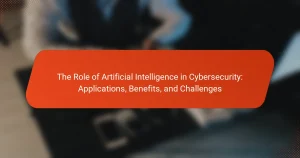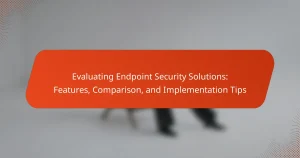Cyber Threat Intelligence (CTI) is critical information that organizations utilize to understand and address potential cyber threats. This article examines the various sources of CTI, including open-source intelligence (OSINT), human intelligence (HUMINT), and technical intelligence (TECHINT), as well as the tools available for assessing CTI, such as ThreatConnect, Recorded Future, and Anomali. The effectiveness of CTI is evaluated through key metrics like accuracy, timeliness, relevance, and actionable insights, which collectively determine its value in enhancing an organization’s cybersecurity posture. By leveraging diverse intelligence sources and effective tools, organizations can significantly improve their ability to detect, respond to, and mitigate cyber threats.
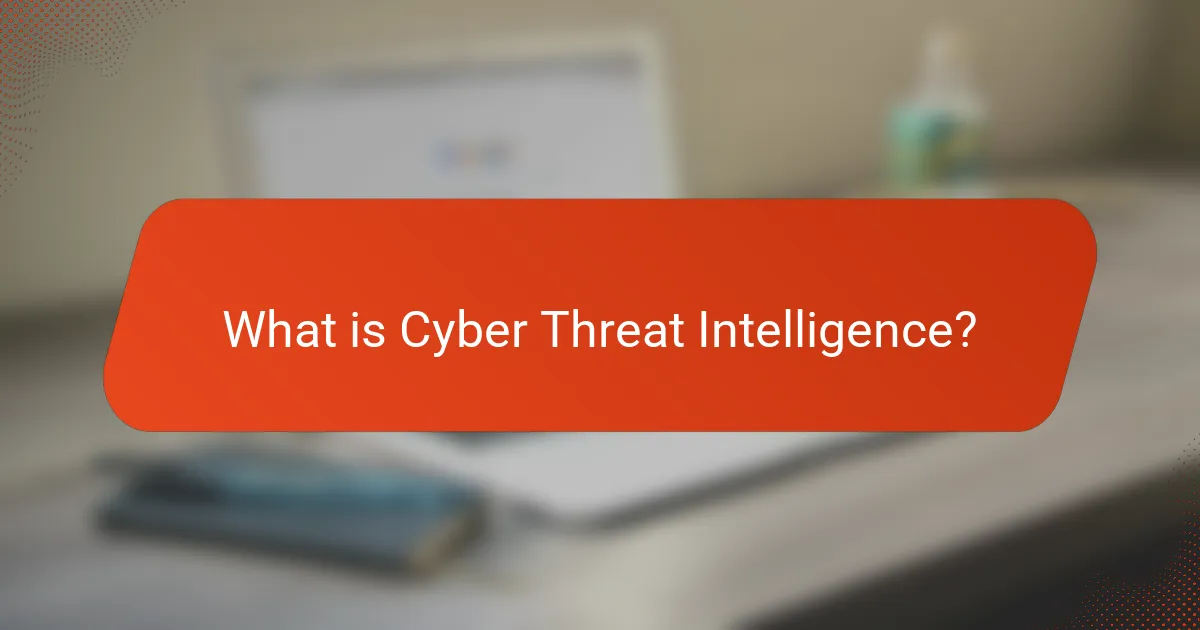
What is Cyber Threat Intelligence?
Cyber Threat Intelligence (CTI) is information that organizations use to understand potential threats to their systems. It involves the collection, analysis, and sharing of data related to cyber threats. CTI helps in identifying, mitigating, and responding to cyber attacks. This intelligence can come from various sources, including open-source data, threat reports, and internal security logs. Effective CTI allows organizations to anticipate and prepare for potential security incidents. According to the Ponemon Institute, organizations that utilize threat intelligence can reduce the cost of a data breach by an average of $1.4 million.
How does Cyber Threat Intelligence function in cybersecurity?
Cyber Threat Intelligence functions in cybersecurity by providing actionable insights into potential threats. It involves the collection, analysis, and dissemination of information regarding cyber threats. Organizations use this intelligence to identify vulnerabilities and improve their security posture. Threat intelligence helps in understanding the tactics, techniques, and procedures used by cyber adversaries. It allows for proactive measures, such as strengthening defenses and mitigating risks. According to the 2021 Cybersecurity Threat Intelligence Report, 67% of organizations using threat intelligence reported improved incident response times. This demonstrates the effectiveness of integrating threat intelligence into cybersecurity strategies.
What are the key components of Cyber Threat Intelligence?
The key components of Cyber Threat Intelligence are data collection, analysis, dissemination, and feedback. Data collection involves gathering information from various sources, such as threat feeds, open-source intelligence, and internal security logs. Analysis entails evaluating this data to identify patterns, trends, and potential threats. Dissemination refers to sharing the analyzed intelligence with relevant stakeholders to inform decision-making. Feedback is crucial for refining intelligence processes and improving future data collection and analysis. Each component plays a vital role in enhancing an organization’s cybersecurity posture.
How do these components interact to enhance security?
Components such as threat intelligence sources, analytical tools, and response mechanisms interact to enhance security by providing comprehensive situational awareness. Threat intelligence sources supply real-time data on emerging threats. Analytical tools process this data to identify patterns and assess risk levels. Response mechanisms implement strategies based on the intelligence gathered. Together, they create a feedback loop that continuously improves security posture. For instance, according to the Ponemon Institute’s 2021 Cost of a Data Breach Report, organizations leveraging threat intelligence reduce breach costs by an average of $1.4 million. This demonstrates the effectiveness of integrating these components in a cohesive security strategy.
What are the different types of Cyber Threat Intelligence?
There are three primary types of Cyber Threat Intelligence: Tactical, Operational, and Strategic. Tactical intelligence focuses on immediate threats and vulnerabilities. It includes information about malware signatures and attack patterns. Operational intelligence provides insights into ongoing threats and how they could affect an organization. This type often includes details about threat actors and their tactics. Strategic intelligence offers a broader perspective on long-term threats and trends. It helps organizations understand the threat landscape and inform decision-making. Each type serves a distinct purpose in enhancing cybersecurity posture.
What distinguishes strategic, tactical, operational, and technical intelligence?
Strategic intelligence focuses on long-term goals and broad trends. It aids in decision-making at the highest levels. Tactical intelligence addresses short-term objectives and immediate actions. It supports decisions regarding specific operations or missions. Operational intelligence bridges the gap, providing insights for ongoing operations and tactical planning. It informs commanders about the current situation and potential threats. Technical intelligence involves detailed information about tools, technologies, and methods used by adversaries. It helps in understanding capabilities and vulnerabilities. Each type serves distinct purposes in the intelligence cycle, ensuring comprehensive situational awareness.
How do these types serve different organizational needs?
Cyber threat intelligence types serve different organizational needs by providing tailored insights. Strategic intelligence informs high-level decision-making and long-term planning. Tactical intelligence supports operational teams in executing specific security measures. Operational intelligence aids in real-time incident response and threat detection. Each type addresses unique aspects of cybersecurity, enhancing overall defense mechanisms. For instance, strategic intelligence helps organizations prioritize threats based on potential impact. Tactical intelligence allows teams to understand attack vectors and techniques used by adversaries. Operational intelligence focuses on immediate threats, enabling swift action to mitigate risks. This differentiation ensures organizations can allocate resources effectively and respond to threats appropriately.
Why is assessing Cyber Threat Intelligence important?
Assessing Cyber Threat Intelligence is important because it helps organizations identify and mitigate potential security threats. This proactive approach allows for a better understanding of the threat landscape. By analyzing threat intelligence, organizations can prioritize their security efforts. It enables them to allocate resources effectively to defend against specific threats. Furthermore, accurate threat assessments can reduce response times during incidents. According to a report by the Ponemon Institute, organizations that leverage threat intelligence can improve their incident response time by 40%. This data underscores the value of thorough assessment in enhancing overall cybersecurity posture.
How does effective assessment impact an organization’s security posture?
Effective assessment enhances an organization’s security posture by identifying vulnerabilities and threats. This process allows organizations to prioritize security measures based on risk levels. For instance, regular assessments can reveal outdated software or misconfigurations that could be exploited. A study by the Ponemon Institute found that organizations with frequent assessments reduce their risk of data breaches by 30%. Furthermore, effective assessment fosters a proactive security culture, encouraging continuous monitoring and improvement. This ongoing evaluation helps organizations adapt to evolving threats and maintain compliance with regulations. Overall, effective assessment is critical in strengthening defenses and mitigating potential security incidents.
What role does assessment play in threat mitigation strategies?
Assessment plays a critical role in threat mitigation strategies by identifying vulnerabilities and potential threats. It enables organizations to understand their security posture. Through systematic evaluation, assessment helps prioritize risks based on their impact and likelihood. This process informs the development of targeted mitigation measures. For instance, the National Institute of Standards and Technology (NIST) emphasizes the importance of risk assessments in their Cybersecurity Framework. Regular assessments allow for timely updates to security protocols, ensuring adaptability to evolving threats. Ultimately, effective assessment enhances an organization’s ability to respond to incidents and minimize damage.
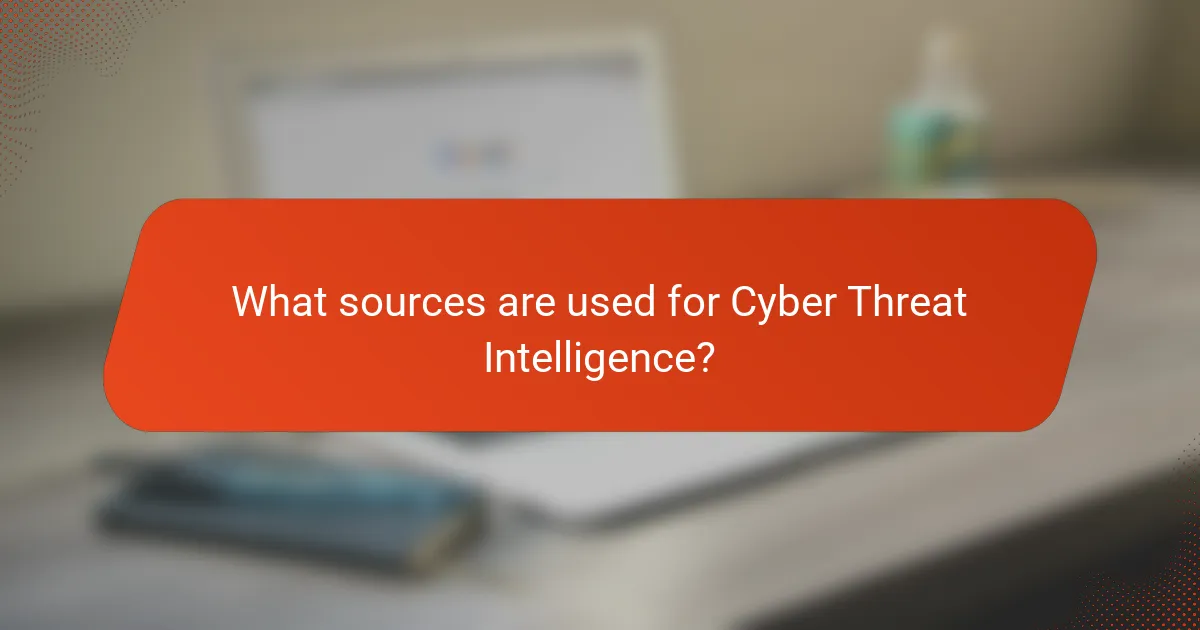
What sources are used for Cyber Threat Intelligence?
Cyber Threat Intelligence sources include open-source intelligence (OSINT), human intelligence (HUMINT), and technical intelligence (TECHINT). OSINT involves publicly available information such as news articles, blogs, and social media. HUMINT relies on information gathered from human sources like informants or industry contacts. TECHINT focuses on data derived from technical means, such as network traffic analysis and malware analysis. These sources provide valuable insights into potential cyber threats and vulnerabilities. Their effectiveness is supported by numerous cybersecurity reports indicating that diverse intelligence sources enhance threat detection and response capabilities.
What are the primary sources of Cyber Threat Intelligence?
The primary sources of Cyber Threat Intelligence include open-source intelligence, human intelligence, technical intelligence, and commercial threat intelligence feeds. Open-source intelligence comprises publicly available data from websites, forums, and social media. Human intelligence involves insights from cybersecurity professionals and industry experts. Technical intelligence refers to data derived from network traffic analysis and malware analysis. Commercial threat intelligence feeds provide curated and analyzed threat data from specialized vendors. Each source contributes unique insights that enhance an organization’s understanding of potential cyber threats.
How do open-source, commercial, and internal sources differ?
Open-source, commercial, and internal sources differ primarily in accessibility, ownership, and data origin. Open-source sources are publicly available and can be accessed by anyone. Examples include community-driven platforms and publicly shared threat intelligence feeds. Commercial sources are proprietary and require payment for access. These often provide curated and analyzed data from experts in the field. Internal sources are generated within an organization, based on its own data and experiences. They provide unique insights but may lack external validation. Each type serves distinct purposes in cyber threat intelligence, with open-source being cost-effective, commercial offering depth, and internal providing tailored insights.
What are the advantages and disadvantages of each source type?
The advantages and disadvantages of each source type in cyber threat intelligence vary significantly. Open-source intelligence (OSINT) is accessible and cost-effective. However, it may lack reliability due to potential misinformation. Human intelligence (HUMINT) provides context and insights from individuals. Its drawback is the potential for bias and limited scalability. Signals intelligence (SIGINT) offers real-time data and monitoring capabilities. The disadvantage is the complexity and cost of acquisition. Technical intelligence (TECHINT) provides detailed information about vulnerabilities. However, it may require specialized knowledge to interpret. Each source type has unique strengths and weaknesses that impact effectiveness in cyber threat assessment.
How can organizations evaluate the reliability of these sources?
Organizations can evaluate the reliability of cyber threat intelligence sources by assessing their credibility, accuracy, and relevance. Credibility can be determined by examining the source’s history and expertise in the field. Accurate information can be verified against multiple independent sources to ensure consistency. Relevance involves analyzing whether the intelligence aligns with the organization’s specific context and threat landscape. Additionally, organizations can utilize established frameworks, such as the Cyber Kill Chain or MITRE ATT&CK, to contextualize the intelligence. These frameworks provide a structured approach to understanding threats. Regularly updating the evaluation criteria based on emerging threats also enhances reliability assessments.
What criteria should be used to assess source credibility?
To assess source credibility, evaluate the authority, accuracy, objectivity, currency, and coverage of the information. Authority refers to the qualifications and expertise of the source. Accuracy involves verifying facts and data against reliable references. Objectivity assesses potential biases that may affect the information’s presentation. Currency checks if the information is up-to-date and relevant. Coverage examines the comprehensiveness of the source in addressing the topic. These criteria are essential in determining the reliability of sources in cyber threat intelligence.
How does source reliability affect the overall intelligence quality?
Source reliability directly influences overall intelligence quality. Reliable sources provide accurate and credible information. This accuracy enhances the validity of the intelligence produced. Conversely, unreliable sources can lead to misinformation. Misinformation can result in poor decision-making and increased vulnerability to threats. A study by the National Institute of Standards and Technology highlights that reliable data sources improve situational awareness. Enhanced situational awareness leads to better threat assessments. Thus, the integrity of the source is crucial for effective intelligence outcomes.
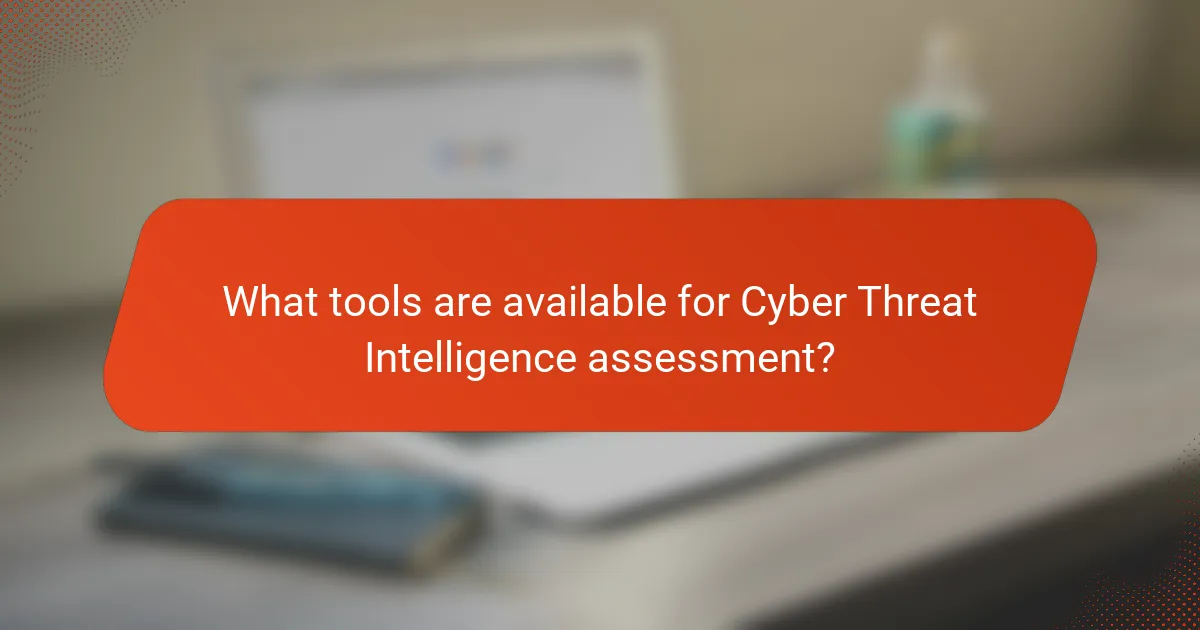
What tools are available for Cyber Threat Intelligence assessment?
Tools available for Cyber Threat Intelligence assessment include ThreatConnect, Recorded Future, and Anomali. ThreatConnect provides a platform for threat data aggregation and analysis. Recorded Future offers real-time threat intelligence powered by machine learning. Anomali enables organizations to detect, respond to, and mitigate threats effectively. Other notable tools are MISP (Malware Information Sharing Platform) and IBM X-Force Exchange, which facilitate threat sharing and collaboration. These tools enhance situational awareness and improve response strategies against cyber threats.
What are the most commonly used tools for Cyber Threat Intelligence?
The most commonly used tools for Cyber Threat Intelligence include ThreatConnect, Recorded Future, and Anomali. ThreatConnect provides a platform for threat intelligence aggregation and analysis. Recorded Future offers real-time threat data and analysis based on web intelligence. Anomali focuses on threat detection and response through integration with existing security tools. Other notable tools are MISP, which facilitates sharing of threat intelligence, and IBM X-Force Exchange, known for its extensive threat data repository. These tools help organizations identify, analyze, and respond to cyber threats effectively.
How do these tools facilitate data collection and analysis?
These tools facilitate data collection and analysis by automating the gathering of relevant data from various sources. They streamline the process of identifying potential threats by using algorithms to sift through large volumes of information. This automation reduces the time and effort required for manual data collection.
Additionally, these tools employ advanced analytics to process and interpret the collected data. They can identify patterns and correlations that may not be immediately obvious to human analysts. For example, machine learning algorithms can enhance the accuracy of threat predictions.
Furthermore, visualization features within these tools help present complex data in an understandable format. This allows analysts to make informed decisions quickly. The integration of real-time data feeds ensures that the analysis is based on the most current information available.
Overall, these tools significantly enhance the efficiency and effectiveness of data collection and analysis in the context of cyber threat intelligence.
What features should organizations look for in these tools?
Organizations should look for comprehensive data integration in cyber threat intelligence tools. This feature allows the aggregation of information from various sources. Real-time threat detection is essential for timely responses to incidents. User-friendly interfaces enhance usability for security teams. Customizable dashboards provide tailored insights specific to organizational needs. Automated reporting features save time and improve efficiency. Collaboration capabilities facilitate communication among team members. Finally, strong support and training resources ensure effective tool utilization.
How can organizations integrate these tools into their security frameworks?
Organizations can integrate cyber threat intelligence tools into their security frameworks by aligning them with existing security protocols. They should assess current security measures and identify gaps that these tools can fill. Integration involves configuring the tools to share data with security information and event management (SIEM) systems. This allows for real-time threat detection and response.
Training staff on how to use these tools is crucial for effective integration. Regular updates and maintenance of the tools ensure they remain effective against evolving threats. Additionally, organizations should establish clear communication channels between security teams and the tools for streamlined operations.
Research indicates that organizations using integrated threat intelligence tools have reduced incident response times by up to 50%. This demonstrates the effectiveness of proper integration into security frameworks.
What are the best practices for tool integration?
Best practices for tool integration include ensuring compatibility between systems. Conduct thorough assessments of existing tools before integration. Establish clear objectives for what the integration should achieve. Use standardized protocols to facilitate communication between tools. Implement automation to streamline processes and reduce manual errors. Regularly update and maintain integrated tools to ensure optimal performance. Provide adequate training for users to maximize tool effectiveness. Monitor and evaluate integration outcomes to identify areas for improvement.
How can organizations ensure effective use of these tools?
Organizations can ensure effective use of cyber threat intelligence tools by implementing a structured approach. This includes defining clear objectives for using these tools. Organizations should also provide comprehensive training for staff on tool functionalities. Regular updates and assessments of the tools are essential to maintain relevance. Integrating threat intelligence into existing security protocols enhances effectiveness. Collaboration with external threat intelligence sources can provide additional insights. Monitoring and evaluating the impact of these tools on security posture is crucial. According to a report by the Ponemon Institute, organizations that regularly assess their threat intelligence tools see a 30% reduction in security incidents.
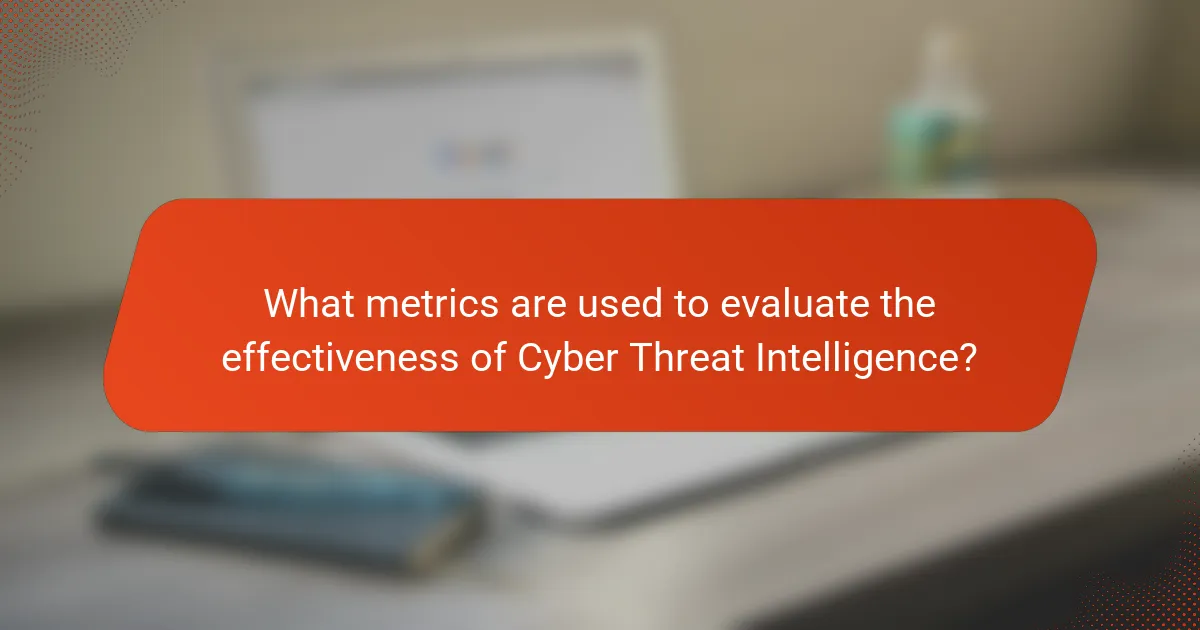
What metrics are used to evaluate the effectiveness of Cyber Threat Intelligence?
Key metrics to evaluate the effectiveness of Cyber Threat Intelligence include accuracy, timeliness, relevance, and actionable insights. Accuracy measures how correctly the intelligence reflects real threats. Timeliness assesses how quickly the intelligence is delivered relative to the threat’s emergence. Relevance evaluates the alignment of the intelligence with the organization’s specific threat landscape. Actionable insights determine whether the intelligence can lead to effective response actions. These metrics collectively help organizations gauge the value of their Cyber Threat Intelligence efforts.
What key performance indicators (KPIs) should be considered?
Key performance indicators (KPIs) for assessing cyber threat intelligence include detection rate, response time, and false positive rate. Detection rate measures the percentage of threats identified by the system. A high detection rate indicates effective threat identification. Response time tracks how quickly the team acts upon detected threats. Shorter response times lead to reduced impact from threats. False positive rate reflects the accuracy of threat alerts. Lower false positive rates enhance operational efficiency. Additional KPIs include incident recovery time and user awareness levels. These metrics collectively provide insights into the effectiveness of cyber threat intelligence efforts.
How do these KPIs help in assessing intelligence quality?
KPIs, or Key Performance Indicators, help in assessing intelligence quality by providing measurable metrics. These metrics evaluate the effectiveness and reliability of cyber threat intelligence. For example, KPIs can track the accuracy of threat predictions. They can also measure the timeliness of intelligence delivery. Additionally, KPIs assess the relevance of the information provided. This enables organizations to determine if the intelligence meets their operational needs. Research indicates that organizations using KPIs improve their threat response times by up to 30%. This demonstrates that KPIs are essential for enhancing intelligence quality.
What benchmarks can organizations use for comparison?
Organizations can use several benchmarks for comparison in cyber threat intelligence. Common benchmarks include industry standards, such as the MITRE ATT&CK framework. This framework categorizes cyber adversary tactics and techniques based on real-world observations. Organizations can also reference the Cybersecurity Framework by NIST. This framework provides a policy framework of computer security guidance.
Another benchmark is the Common Vulnerability Scoring System (CVSS). CVSS offers a way to capture the principal characteristics of vulnerabilities. Organizations may also assess their performance against peer organizations. This can be achieved through industry reports or threat intelligence sharing groups.
Metrics such as time to detect and respond to incidents are also valuable. These metrics help organizations evaluate their threat intelligence effectiveness. Regular assessments against these benchmarks can enhance an organization’s security posture.
What challenges do organizations face when assessing Cyber Threat Intelligence?
Organizations face several challenges when assessing Cyber Threat Intelligence. One significant challenge is the volume of data. The sheer amount of threat data can overwhelm organizations, making it difficult to identify relevant information. Another challenge is the quality of the intelligence. Not all sources provide reliable or actionable insights. Organizations must discern which sources are credible. Additionally, there is often a lack of skilled personnel. Many organizations struggle to find experts who can analyze threat intelligence effectively. Integration with existing security systems poses another hurdle. Organizations may find it challenging to incorporate new intelligence into their current frameworks. Finally, the evolving nature of threats complicates assessments. Cyber threats constantly change, necessitating continuous updates to intelligence processes.
How can organizations overcome these challenges?
Organizations can overcome these challenges by implementing a multi-layered cybersecurity strategy. They should invest in advanced threat detection tools and continuous monitoring systems. Regular training for employees on cybersecurity best practices is essential. Establishing clear incident response protocols can minimize damage during a breach. Collaborating with external cybersecurity experts enhances threat intelligence capabilities. Conducting regular security audits helps identify vulnerabilities. Utilizing threat intelligence sharing platforms improves awareness of emerging threats. These strategies are supported by research indicating that organizations with proactive cybersecurity measures experience fewer breaches.
What lessons can be learned from common assessment pitfalls?
Common assessment pitfalls in cyber threat intelligence highlight critical lessons. One lesson is the importance of clear objectives. Assessments without defined goals lead to ambiguous results. Another lesson is the need for diverse data sources. Relying on a single source can result in incomplete insights. Additionally, proper validation of data is essential. Unverified information can mislead decision-making processes. Regularly updating assessment methodologies is also crucial. This ensures relevance in a rapidly evolving threat landscape. Lastly, involving cross-functional teams enhances assessment accuracy. Collaboration brings varied perspectives that improve overall analysis.
What are the best practices for effective Cyber Threat Intelligence assessment?
The best practices for effective Cyber Threat Intelligence assessment include establishing clear objectives. Organizations should define what they aim to achieve with threat intelligence. This ensures focus and relevance in the assessment process.
Next, gathering data from diverse sources is crucial. Reliable sources include open-source intelligence, internal logs, and threat feeds. This variety enhances the comprehensiveness of the intelligence.
Analyzing the gathered data is another key practice. Organizations should employ analytical frameworks to identify patterns and trends. This step helps in understanding the threat landscape.
Collaboration with other entities is also important. Sharing information with industry peers can lead to better insights and improved defenses.
Finally, continuous evaluation and adaptation of the assessment process are essential. Threat landscapes evolve, and so should the intelligence strategies. Regular updates ensure that the intelligence remains relevant and actionable.
How can organizations develop a robust assessment framework?
Organizations can develop a robust assessment framework by defining clear objectives and metrics. Establishing specific goals helps focus the assessment on relevant outcomes. Next, they should identify the necessary data sources for accurate evaluation. Utilizing diverse data sources enhances the reliability of the assessment.
Organizations must also implement standardized evaluation processes. Standardization ensures consistency and comparability across assessments. Additionally, involving cross-functional teams can provide varied perspectives. Diverse input improves the framework’s comprehensiveness and effectiveness.
Regularly reviewing and updating the framework is crucial. Continuous improvement allows organizations to adapt to evolving threats and technologies. Finally, leveraging advanced analytical tools can enhance assessment accuracy. Tools such as machine learning algorithms can process large data sets efficiently.
What steps should be taken to continuously improve assessment processes?
To continuously improve assessment processes, organizations should implement regular reviews and updates of their methodologies. This includes analyzing previous assessments to identify strengths and weaknesses. Gathering feedback from stakeholders enhances the relevance of the process. Training staff on the latest tools and techniques ensures they are equipped to conduct effective assessments. Integrating new technologies can streamline the assessment process, making it more efficient. Establishing key performance indicators (KPIs) allows organizations to measure the effectiveness of their assessments. Engaging in peer reviews fosters a culture of accountability and continuous improvement. Finally, staying informed about industry trends ensures that assessment processes remain relevant and effective.
Cyber Threat Intelligence (CTI) is a critical component for organizations to understand and mitigate potential cyber threats. This article explores the assessment of CTI, detailing its sources, tools, and effectiveness in enhancing cybersecurity posture. Key topics include the different types of CTI, the importance of reliable data sources, and the role of various tools in data collection and analysis. Additionally, it examines metrics and KPIs for evaluating CTI effectiveness, challenges organizations face, and best practices for continuous improvement in assessment processes.
